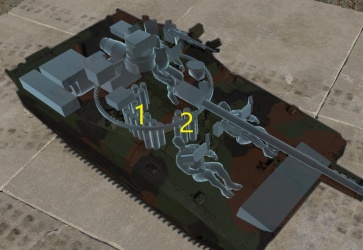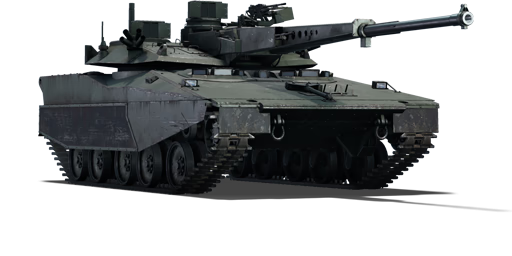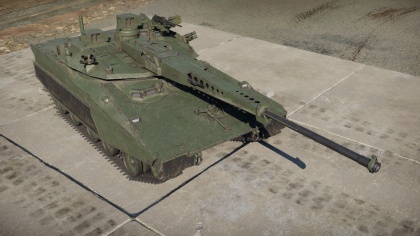HSTV-L
Contents
Description
The High Survivability Test Vehicle — Lightweight is a rank VII American light tank
with a battle rating of 11.7 (AB/RB/SB). It was introduced in Update "Starfighters".
General info
Survivability and armour
| Armour | Front (Slope angle) | Sides | Rear | Roof |
|---|---|---|---|---|
| Hull | 38 mm (80°) | 19 mm Top 38.1 mm Bottom |
25.4 mm | 5 - 19 mm |
| Turret | 25.4 mm Turret front 25.4 mm Gun mantlet |
25.4 mm | 25.4 mm | 25.4 mm |
| Cupola | 25.4 mm | 25.4 mm | 25.4 mm | 25.4 mm |
The HSTV-L is a very lightly-armoured vehicle. The HSTV-L also has hull break, if any "solid" module were to get hit (e.g. gun breech or engine/transmission) the vehicle will be hull broken. Depending on where you get shot you might lose 1 crew member but you will still be alive. If you get shot on the left side of the vehicle from the front, the chances of your ammo rack detonating greatly increases. Best case scenario for this vehicle is to not get hit in the first place.
Mobility
| Game Mode | Max Speed (km/h) | Weight (tons) | Engine power (horsepower) | Power-to-weight ratio (hp/ton) | |||
|---|---|---|---|---|---|---|---|
| Forward | Reverse | Stock | Upgraded | Stock | Upgraded | ||
| Arcade | 93 | 28 | 20 | 1,007 | 1,240 | 50.35 | 62 |
| Realistic | 84 | 25 | 575 | 650 | 28.75 | 32.5 | |
The HSTV-L has a very good power-to-weight ratio making the vehicle decently fast. The vehicle utilizes a 648 HP gas turbine engine. The HSTV-L is very manoeuvrable due to the gas turbine engine and can get to flanking spots early in the game.
Armaments
Main armament
| 75 mm XM274 | Turret rotation speed (°/s) | Reloading rate (seconds) | |||||||||||
|---|---|---|---|---|---|---|---|---|---|---|---|---|---|
| Mode | Capacity | Vertical | Horizontal | Stabilizer | Stock | Upgraded | Full | Expert | Aced | Stock | Full | Expert | Aced |
| Arcade | 26 | -17°/+45° | ±180° | Two-plane | 54.3 | 75.1 | 91.2 | 100.9 | 107.3 | 1.5 | 1.5 | 1.5 | 1.5 |
| Realistic | 33.9 | 39.9 | 48.5 | 53.6 | 57.0 | ||||||||
Ammunition
| Penetration statistics | |||||||
|---|---|---|---|---|---|---|---|
| Ammunition | Type of warhead |
Penetration @ 0° Angle of Attack (mm) | |||||
| 10 m | 100 m | 500 m | 1,000 m | 1,500 m | 2,000 m | ||
| XM885 | APFSDS | 276 | 269 | 262 | 252 | 243 | 234 |
| Shell details | |||||||||
|---|---|---|---|---|---|---|---|---|---|
| Ammunition | Type of warhead |
Velocity (m/s) |
Projectile Mass (kg) |
Fuse delay (m) |
Fuse sensitivity (mm) |
Explosive Mass (TNT equivalent) (g) |
Ricochet | ||
| 0% | 50% | 100% | |||||||
| XM885 | APFSDS | 1,463 | 2.2 | N/A | N/A | N/A | 78° | 80° | 81° |
Ammo racks

| Full ammo |
1st rack empty |
2nd rack empty |
Visual discrepancy |
|---|---|---|---|
| 26 | 7 (+19) | 1 (+25) | No |
Notes:
- Rack 2 is a ready rack, so although shells deplete from that rack after firing, it will refill from rack 1.
Machine guns
The HSTV-L has 2 M240 machine guns. One is fixed to the gun mantlet and the other is mounted on the Commander's cupola. These machine guns can be used to mark enemies for your allies and can also be used to shoot down some lighter aircraft, but be careful as shooting them will give away your location and can result in them strafing and destroying your vehicle.
| 7.62 mm M240 | ||||
|---|---|---|---|---|
| Mount | Capacity (Belt) | Fire rate | Vertical | Horizontal |
| Coaxial | 1,600 (200) | 750 | N/A | N/A |
| Pintle | 1,600 (200) | 750 | __° | 190° |
Usage in battles
The HSTV-L is a light tank with a quick ready-rack reload, making it adept at dealing with multiple enemies in ambush situations. It can achieve a very good top speed thanks to its light weight and has a similarly good turning ability. With this mobility (which is on par with that of top MBTs), the HSTV-L can achieve desirable early-game positions and move quickly around the map when necessary.
Like most light tanks, this vehicle is lacking in the protection department. It has thin armour in all directions, which is not backed up by any spaced or composite protection, and is susceptible to hull-break. In some situations, the armour may be thin enough that kinetic rounds overpenetrate and pass straight through the vehicle without causing much damage. The highly-angled armour can also sometimes bounce shots. In most cases though, the HSTV-L cannot be counted on to sustain heavy fire.
This tank is fairly unique in that it is equipped with an autoloader with a 6-round ready-rack. This means that the first 6 shots fired from the HSTV-L can come in very rapid succession--the reload time for these shells is a mere 1.5 seconds. After these first rounds, the ready-rack is empty and the reload time increases dramatically. The player must take this into account when deciding which enemies to engage. The HSTV-L can pull off short bursts of high firepower, but needs time to replenish its ready-rack. The shell itself, an APFSDS round, is decent, but may have trouble penetrating the frontal armour of top MBTs. This combined with the vehicle's poor armour means that head-on attacks are rarely advisable.
The HSTV-L is better suited to firing at enemies without their noticing--from ambush positions, from the flanks, and from behind corners. The vehicle's great mobility will aid with this playstyle. Indeed, its mobility is what makes the HSTV-L great on urban maps. Furthermore, in ambush situations the tank is able to easily deal with multiple enemies thanks to its fast ready-rack reload. This tank has a 45 degree gun elevation and a 17 degree gun depression. This gun depression is extremely powerful, and makes the vehicle very effective at hill camping and at firing from behind ridgelines. A thermal sight in both gunner and commander/binocular views makes the HSTV-L a great scouting vehicle. It is recommended to use the vehicle's high mobility to aid in scouting enemies for teammates to locate and destroy.
Modules
| Tier | Mobility | Protection | Firepower | |||
|---|---|---|---|---|---|---|
| I | Tracks | Parts | Horizontal Drive | |||
| II | Suspension | Brake System | FPE | Adjustment of Fire | Airstrike | |
| III | Filters | Crew Replenishment | Elevation Mechanism | Laser rangefinder | Smoke grenade | |
| IV | Transmission | Engine | Artillery Support | Improved optics | NVD | |
Pros and cons
Pros:
- The cannon has a very good ROF with a 1.5s reload
- Due to its light armour, some kinetic rounds may over penetrate, leaving it untouched
- Excellent urban fighting vehicle as in up-tiers, side shots are much more effective
- Internal 30 mm armour can help protect crew
- Thermal sight for both gunner and commander = Great scouting vehicle
- Up to 45° elevation and -17° depression.
- Very good gun handling
Cons:
- As with all light vehicles, it is susceptible to the "Hull Break" mechanic
- Commander's cupola can be penetrated by heavy machine gun fire
- Limited ammo, at only 26 rounds
- Extremely poor ammo selection; can only fire APFSDS
- APFSDS round has problems penetrating frontal armour of later MBTs
- The APFSDS shell is designated as short-rod, causing minimum damage after penetration
- The cannon has relatively low penetration
- Average mobility even with 32hp/t and low ground pressure
History
The high-survivability test vehicle (HSTV-L) was a prototype and was started because the army was interested in new technologies and focused more on light combat vehicles as it was believed that they would be able to survive for a lot longer in combat, since its small and hard to hit. It was funded by the Defense Advanced Research Projects Agency (DARPA) and completed in 1980, had a crew of 2-3 (commander, gunner, driver) and was a full track powered by a 650-hp gas turbine engine which could reach 84km/h (52mph). It had a very low profile turret which was fitted with a developmental 75mm Medium Caliber Anti-Armor Automatic Cannon, the sights were fitted with FLIR and the tank weighted around 20.5t (20,500kg). The HSTV-L allowed the tests of lightweight systems which would enable it to be an effective assualt tank against armour or used as a defensive system. It would also enable the crew to test their performance in various conditions. During the development there were few delays with the hardware. However that was expected since they were working with high-tech equipment. The vehicle was later developed in to the RDF/LT as it did not enter service.
Devblog
By the mid 1970’s, the US military initiated a series of studies which looked into the development of new concepts and designs for tanks which combined good firepower and survivability. The latter of which was to be achieved through a smaller size, rather than heavy armor protection.
As at the time, both the US Army and USMC were looking into possible replacements for their M551 Sheridan and M50 Ontos tanks respectively, the two military branches joined forces in a joint research programme dubbed “ARMVAL” (Advanced Antiarmor Vehicle Evaluation). The vehicles developed under this programme would be used as test beds for various new concepts and ideas in an effort to gain new experiences, which would in turn be used in the development of future tank designs.
One of the later products of this experimental programme was the HSTV-L - a compact, lightweight, highly mobile tank design, fitted with an autoloaded 75mm smoothbore cannon, designed to fire kinetic ammunition in short bursts in order to wear down and ultimately defeat composite armor screens. The HSTV-L was built in 1979 and underwent various trials until 1981.
At the start of the 1980’s, the 75mm gun was considered inadequate to deal with the most recent Soviet MBTs by the Army, while the USMC questioned the vehicle’s effectiveness in amphibious landing operations. This led to the ultimate discontinuation of the collaborative project in 1981.
Media
- Skins
- Videos
See also
- Tanks at similar positions in other tech trees:
- VFM 5 - A British light tank
- CV90105 TML - A Swedish light tank
- TAM 2C - A German light tank
- Object 685 - A Russian light tank
External links
| USA light tanks | |
|---|---|
| LVT | LVT(A)(1) · ○LVT(A)(1) · LVT(A)(4) |
| M2 | M2A2 · M2A4 · M2A4 (1st Arm.Div.) |
| M3/M5 Stuart | M3 Stuart · M3A1 Stuart · M3A1 (USMC) · M5A1 · M5A1 TD · ▃Stuart VI (5th CAD) |
| M22 Locust | M22 |
| M24 Chaffee | M24 · M24 (TL) |
| M18 Hellcat | M18 GMC · M18 "Black Cat" · Super Hellcat |
| M41 Walker Bulldog | M41A1 |
| M551 Sheridan | M551 · M551(76) |
| M3 Bradley | M3 Bradley · M3A3 Bradley |
| Wheeled | M8 LAC · T18E2 · M1128 · M1128 Wolfpack |
| Other | M8A1 GMC · T92 · T114 · HSTV-L · CCVL · XM8 · XM800T · AGS |





